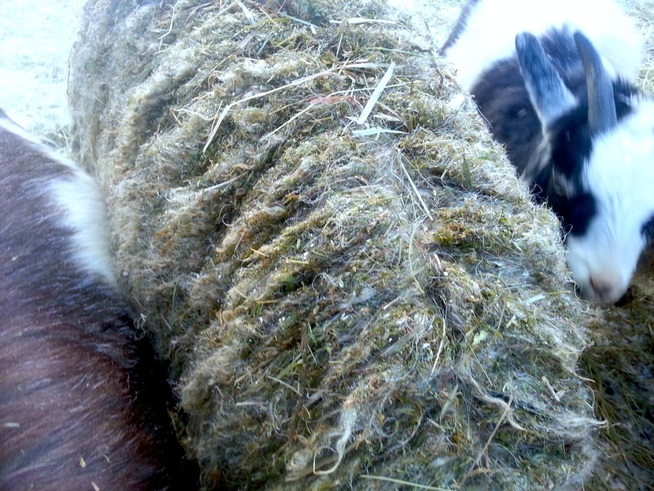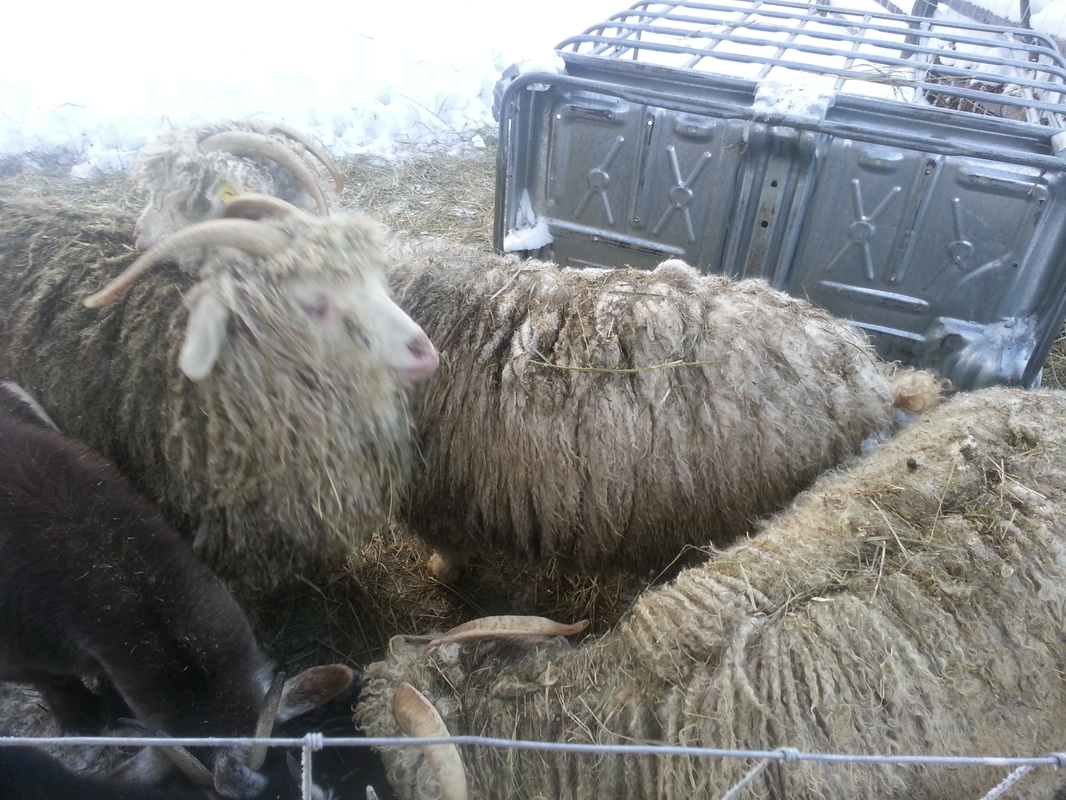 This Angora stands more or less under the feeder area and the fiber is completely integrated with alfalfa leaves and rendered useless.
This Angora stands more or less under the feeder area and the fiber is completely integrated with alfalfa leaves and rendered useless. The goats are the lowest on the herd hierarchy, so are best on their own. On the farm, there are also Nigerian Dwarf, Pygmy and French Alpine goats. The Angoras are among the largest, however; they are pushed aside by even the smallest Pygmy goat.
Because they are horned and large, they cannot eat through feeders as easily. As a matter of fact, feeding them is a problem. They require a high protein food to keep their body condition up because they are producing so much fiber and the fiber is all protein. Most Angora breeders have resorted to feeding pellets to keep the alfalfa hay out of the fibers and to provide the high protein requirements, plus the copper and other minerals required. The angoras on this farm are fed with the other goats, but have to be fed in a different place and even then they are pushed aside. They receive 50% alfalfa hay, green and fresh, as do the rest of the ruminants on the farm and are doing well with it, but their fiber is ruined because of it. One goat in particular stands under the others as they feed, and the fine leaves of the alfalfa go onto the back and catch in the fiber. This is extremely difficult to clean and results in a ruined fiber crop.
The goats produce such copious amounts of mohair, they need to be sheared twice annually and their hooves grow at that same rate and need constant maintenance. But here, in northeastern Alberta, it is very cold in the winter and timing must be precise. We have cold springs too so shearing early in March and early in September is ideal. The goats shiver and are cold and require extra care for the first few weeks after shearing.
The goats do not produce twins as often as they do have single births. The babies are weak when born, not robust and running as the Pygmy babies, for example, and the mothers often need assistance and care to ensure they tend the babies properly. It is crucial that the baby drinks within a short period after birthing. The last first time mother booted her baby away and did not understand she was supposed to feed him. Many times daily, I had to coral her and hold her so he could nurse, until she got the idea.
So, with the intensive management that Angora goats require, they will be leaving the farm. I may keep #72, who seems to be hardier than her sisters, just for her fiber, which also is exceptional. She would be bred to either an Angora or Pygmy, depending on how this crop of babies turns out. The Angora was turned out to breed all the goats, hoping to produce some Pygoras and Nygoras, crosses that produce coloured different fiber quite sought after by handspinners.
There is one buckling from last March, not related to the two females that will be for sale this year. They are purebred and from registered stock, but not registered. Their tags are still in place and if the buyer wishes to register them, it would be quite simple and not expensive. But, that is it for the Angora trial on the Fat Ewe Farm! Learning is by trial and now I know. They are simply much too much effort for the farm to keep and since there is no demand for fiber with vegetative matter and they will not be switched to pellets, because they contain GMO grains, they simply do not fit in. So, long. It was nice to know ya'!


 RSS Feed
RSS Feed